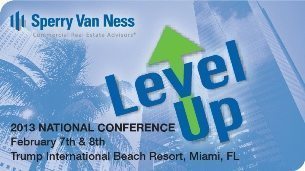With less than 100 days remaining in 2011, I want to pose the following question: “What will YOU do differently in 2012?” You cannot simply repeat your 2011 performance in 2012 and expect the outcome to be any different. My message is a rather simple, yet important one – the market doesn’t matter, but YOUR actions do! Accepting the norm accomplishes little more than sentencing yourself to mediocrity, while radicalizing the norm creates opportunity even when markets don’t seem to be sympathetic to your cause.
5
While commercial real estate markets are certainly not static, I’m always surprised at the numbers of people who operate as if they were. As the landscape around them changes, rather than understanding and adapting to new market drivers, many just prefer to pretend as if it’s business as usual. However, it is those who adapt to the fluidity of the market who become innovative market leaders, and who thrive during even the toughest of market conditions. Likewise, it is those who refuse to change with the times that push themselves into irrelevancy, and eventually become self-inflicted casualties of the weeding-out process.
5
What is not so obvious is that during times of adversity come the greatest opportunities. Those who thrived during the past few years understood this principle, and as a result, they will likely be the ones who lead the way in 2012 as well. Successful companies adapt their business models, re-engineer their business practices, and implement new strategies and tactics while their peers sit on the sidelines wondering what went wrong.
5
Rather than talking about constricted capital markets, successful companies seek out the investors and lenders still doing deals, and restructure transactions to fit the changing guidelines of active capital partners. Rather than complain about transaction bottlenecks, the smart players work with institutions and special assets groups to work around and through the logjams. Rather than work with brokers replete with excuses about why they’re not successful, they find brokers who focus on outcomes and not excuses. They key to success in down markets is to participate in the present while looking toward the future, but refusing to allow yourself to live in the past.
5
So some chest pounding now – not to advertise, but because I think it’s relevant:
5
At Sperry Van Ness we’ve led the charge to radicalize the brokerage industry. Since our inception we’ve done business differently than other brokerage firms. From pioneering an open-source brokerage model, to being the first brokerage firm to mandate 100% social media adoption, to being the first to have an in-house auction firm, to being the first to adopt a cloud-based business platform, we have focused on doing business based upon where the market is headed, not where it’s been.
5
At Sperry Van Ness, we realized several years ago that traditional business models could not service non-traditional markets. When our competitors were cutting back as they adopted the bunker mentality of watch and wait, we were growing, and we did it based on a debt-free, profitable business model. It was clear to us that we needed to continue to adapt to the needs of our clients, and that together, we would not only survive the challenges of changing markets, but we would thrive amidst them.
5
My encouragement to you as we enter 2012 is to refuse to buy into the negative rhetoric. Don’t settle for working with advisors who offer excuses, engage professionals whose work demonstrates they value your relationship as much as they say they do. Don’t tolerate brokers who embrace the status quo, but look for those who shatter it. Look for business partners rather than vendors. Find those firms willing to serve you, regardless of whether a commission exists or not. Look for those willing to embrace change, those who innovate, and those who radicalize the norm.
5
If you haven’t experienced working with a brokerage firm that embodies the ethos I’ve described above, then I invite you to contact us and experience the Sperry Van Ness difference for yourself.
– Kevin Maggiacomo, CEO & President, Sperry Van Ness International Corporation
*All Sperry Van Ness® offices are independently owned and operated.




















